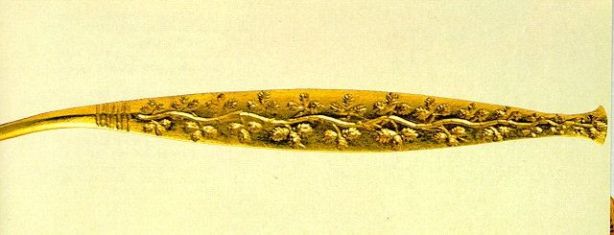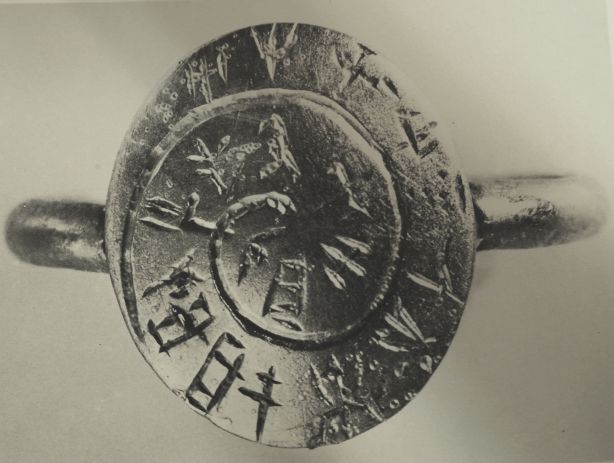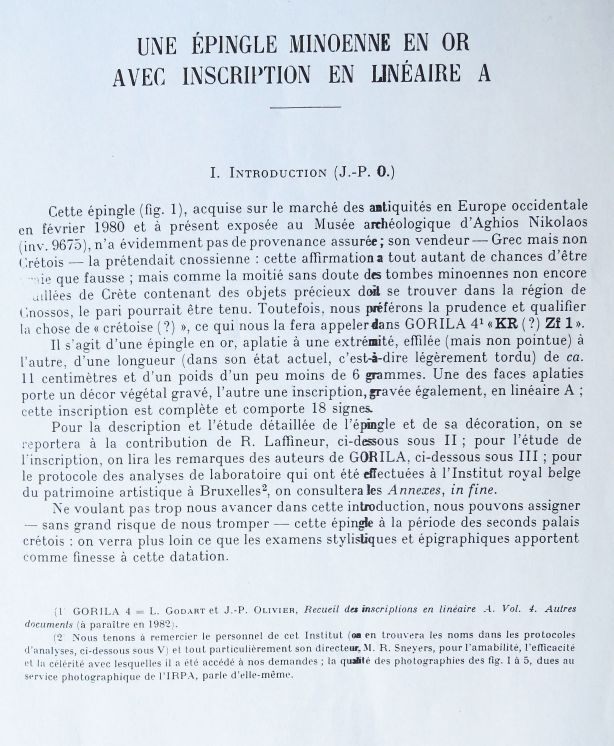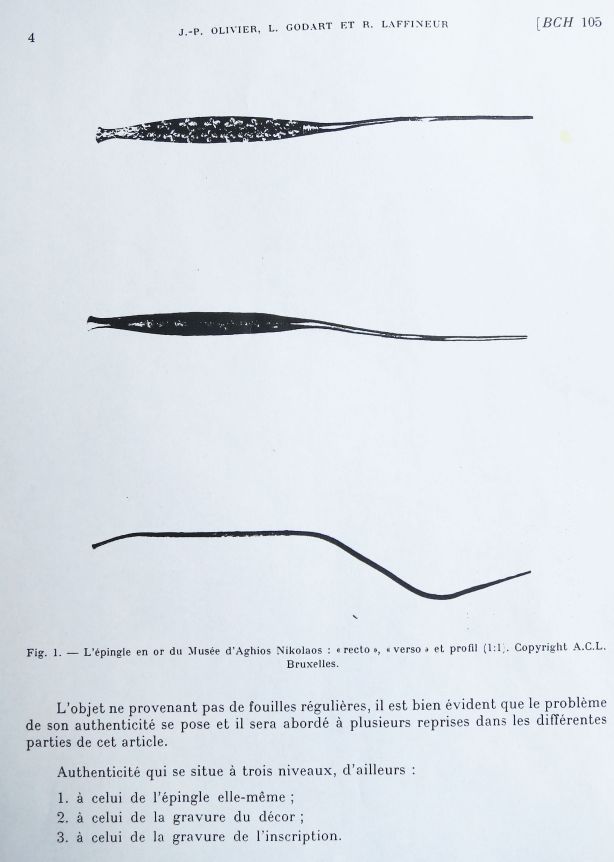Agios Nikolaos, Crete , Archaeological Museum
Is the Minoan Golden Needle given by Jean Piere Olivier in 1981 genuine?
By Sven Buchholz
Gorilla. CR Zf 1. Epingle d΄or. Measure 5 cm !
I first came to visit the archaeological museum of Agios Nikolaos in 1993. This archaeological Museum is relatively small, but with regard to findings from the Minoan epoch it is amongst the biggest in the world. This is probably because the most interesting Minoan findings were made within a 100 km range from Agios Nikolaos. The Museum of Sitia, also in the same province Lasithi, has also got a substantial collection from the same period.The museum is exhibiting big and small objects from the early Minoan period and up to the Hellenic around 400 BC.
In order to absorb all you can see in the museum it is necessary to take a small section only at atime . Today, 19 years after my first visit, I must admit that there is one, probably the smallest object of the entire museum that has caught most of my attention. Consequently I must admit that I had to look at it every time I visited the collection.
The object on the picture is a piece of jewellery, a needle made of pure gold. On one side there is an engraved a floral motif, many small and larger flowers alongside a spiral stalk. Looking at the picture one must have in mind that the engraved part of the needle is only 5cm long! One of my first questions was how it could be possible for the Minoans to make such microscopic engravings without having access to magnifying glasses? The most mysterious about the needle is that on the reverse side there are engraved 18 characters of the hitherto undeciphered Minoan writing LINEAR A! In order to help the visitors of the museum to see the needle accurately, it is mounted with a magnifying glass!
To me the needle represents a triple mystery:
1. What was the meaning of the 18 characters of Linear A?
2. How was it possible for the Minoans to produce this quality of engraving?
3. What was the purpose, the function of this needle with its engraving?
I am sure that many of the visitors in the museum have wondered about the meaning of the inscription.
The significance of a high culture is first and foremost the existence of a writing system. During the various excavations in Crete there were found 3 different systems: The hieroglyphic (The Phaistos Disc), the Linear A and the Linear B. The Linear A and B are both syllable systems. Linear B has been deciphered by Michael Ventris and John Chadwick. It was possible to decipher Linear B because there was a lot of available material in form of clay tablets to be found in Knossos. It was also found that the language was an early dialect of Mycenaean Greek, 500 years before Homer.
Unfortunately, due to negligence and carelessness by Sir Arthur Evans, the excavator of Knossos and the inventor of the Minoan civilisation, hundreds of Linear A tablets were destroyed by rain since he left them in a shelter at Knossos without a roof! Had we only had these to our disposal, we might have deciphered Linear A by now!
We have not got many documents of Minoan Linear A. From Egyptian harbour documents it has been established that the Minoans bought papyrus in Egypt. Looking at the Linear A sign it becomes clear that the signs are designed to be written with a sort of pen on papyrus. The Cretan climate is however too humid for any piece of papyrus to have survived. Most of the pieces that have survived are to be found on clay tablets. This material was used for more serious, probably official documents.
Two French linguists, Louis Godart, and Jean-Pierre Olivier from the French School of Athens spent a great deal of their life in researching the Linear A. The two professors never tried to decipher the writing, what they did was to systemize and classify all the available findings.
In 1975 they issued their work in 5 very big volumes. Jean-Pierre Olivier, who was well known as a humorist and a great practical joker, called the work for GORILLA! The Linear signs he called COMICS and the Cretan hieroglyphs he called CHICK!
These enormous books are most impressive with the very well executed systematisation of all findings made up till 1975.
If you take the time to go through the books, the first impression you get is that there are not many of the texts that are long enough to convey a meaningful message. For this reason I am afraid it will not be possible to decipher the Linear A, taking in consideration that the language is unknown. Hopefully we will in some future find more Linear A texts. I have hope for the excavations in Akrotiri at Santorini and in Palaikastro where Sandy Mac Gillivray from the British School of Athens, by the use of radar scanning has found evidence of yet another palace.
Concerning the engraving Evans has stated that it is quite possible that the Minoans had magnifying glasses made of crystal!
The only rational purpose I can guess, for the needle is to be given as a gift.
That is probably also the content of the inscription!
The biggest Minoan document that was ever found is the Phaistos Disc. It has 242 hieroglyphic characters. There are however only 42 of them that are different. The disc was found in 1908 by the Italian archaeologist Louis Pernier in connection with the excavations of Phaistos.
https://araenil.wordpress.com/2011/06/19/is-the-phaistos-disc-genuine/
Some of the signs have also been found on the Arkalochori Axe. The bronze Arkalochori Axe is a second millennium BC Minoan votive double axe excavated by Spyridon Marinatos in1934 in the Arkalochori cave. It is inscribed with fifteen hieroglyphic signs. It has been suggested that these might be Linear A but Professor Glanville Price agrees with Louis Godart that «the characters on the axe are no more than a ‘pseudo-inscription’ engraved by an illiterate in uncomprehending imitation of authentic Linear A characters on other similar axes».
If we put all the hieroglyphs together we end up with less that 50 hieroglyphic signs. Nobody could possibly claim that the hieroglyphs on the disk or the axe fit into a phonetic system such as the Greek or the Latin alphabet. The systems we know need only 22 to 35 characters. Linear B has little more than 100 characters. It is therefore simple arithmetic to conclude that no syllable system consisting of only 45 characters would be able to convey any intelligent message. For idiomatic pictogram systems we all know it takes thousands of characters, ref. Chinese and Japanese! For this reason I have always been sceptical to both the axe and the disk!
The truth is however that now, 19 years after my first visit to the Museum, my scepticism concerning the Golden Needle Gorilla. CR Zf 1. Epingle d΄or has increased.
The CR Zf 1 is not the only Linear A document that is engraved on a piece of metal jewellery. Evans found one in Knossos with 46 Linear A signs. Gorilla KN Zf 31 , engraved on silver «Epingle d’ Argent«, and KN Zf 13 on gold. There is however no resemblance between the engraved motifs on these 2 objects and Gorilla. CR Zf 1.
Gorilla KN Zf 31
Gorilla KN Zf 13
Ring in gold.
I have looked through all available material on Minoan art history. Each Minoan period is distinctly noticed by the type of motifs to be found on pottery, terracotta etc. I have not been able to find even a remote likeness between the needle and any Minoan period in art history.
In “Gorilla” all objects are clearly defined by the place each single object was found. The needle CR Zf 1 is the only object where the place it was found is totally unknown! What we know is that the CR Zf 1 was given to the museum by one of the two Frenchmen Jean Pierre Olivier in 1937. He claimed he had found it on an antique market in Brussels! With the needle, the Museum also got a detailed report with detailed analyses. Another point that increases my suspicion is the difference between the front and the back side! Whilst the side with the flowers is engraved with the highest calibre of craftsmanship, the back can almost be described as the opposite! It looks rather amateurish! The surface is very rough and the signs have been engraved very roughly.
Even if the Minoans had magnifying glasses I can hardly see how they could have managed this almost microscopic engraving, much smaller than on all the other known Minoan pieces of jewellery! I also doubt that magnifying glass made of crystal could have been able to give a clear enough image.
Having found no resemblance of the motive in Minoan or even Mycenaean art history I extended my area of search, distributing pictures to my entire international network of people with knowledge of art history. I did not tell the origin of the object, i.e. that it was exhibited in a museum as a Minoan artefact.
The answer came relatively quick from some of the sources, and they were as good as identical:
The motive is clearly inspired by Italian design from around 1870 – 1890!
I did not get a shock; I more or less expected something in that direction! Little by little I received more detailed information: The engraving has great resemblance with the school of Florentine floral design made around 1870 / 90. The style with whichthe needle is engraved is however not quite synonymous! The object may have been moulded in a cast. The cast may well have been made partly by stamping the identical flowers into the mould! This procedure moves the time aspect into the 20th century! After World War I the cheap mass produced jewellery came on the market, known as bijouterie. Many well known jewelleries and artefacts were copied and mass produced in exactly this way. One of my contacts mentioned the object as being Bohemian, that means it comes from today’s Czech Republic! They specialized in the 1920 – 30 in making exactly this type of mass produced jewellery, using all sorts of existing motives as models. The production is still going on! The object is most likely to have been produced 1925 – 1935. Olivier has probably made a copy in pure gold. He remooved the one side and added the Linear A signs. Not a very good job if I may say so!
These are my points of suspicion:
-
- The object has no resemblance with any decoration of the entire Minoan art history.
- The engraving is too microscopic to have been done 1600 years BC.
- Contrary to all other Minoan objects, the place where the needle was found is unknown.
- The pattern has a strong resemblance with Florentine floral design from the 19 century.
- The production technique is likely to be one of mass production, time 20 century, place Bohemia.
- The needle was given to the AgiosNikolaosMuseum by Olivier as late as 1982! Where was the needle found, when? The story tells that the needle was “found” by the same Olivier on a Brusselsantique market!”This needle is the only object in the entire museum that we do not have any information about where it was found! Is it at all likely that this small object cold have escaped from any known archaeological excavation? Where was the needle kept all the time until Olivier found it?
- With the needle there was an extensive report, written on 27 pages with all possible scientific analyses made by Olivier himself. Also the report he produced, obtainable from the Agios Nikolaos Archaeological Museumis highly suspicious! It is exactly like the one someone would have made in order to cover! up for a stunt like this?
http://www.persee.fr/web/revues/home/prescript/article/bch_0007-4217_1981_num_105_1_1928
Oliviers report page 1.
Another page of Olivier’s 27 pages report showing shape of needle from all sides.
The other piece of Minoan metal jewellery Gorilla CR Zf 13 and CR Zf 31, found by Evans at Knossos is an obvious model for Gorilla CR Zf 1. Epingle d΄or !
Jean Pierre Olivier was well known as a humorist and a practical joker. Of course Olivier knew that the motif was very far from resembling any Minoan decoration! However, an honest practical joker may well leave a clue, such as the Italian design and the difference between front and back!
Even if the needle maybe a fake, the engraved Minoan signs in Linear A may well be authentic. Olivier may well have anticipated that the Linear A enigma sooner or later may be solved and the script encrypted. He had for a certain period access to a lot of material, such as the clay tablets from Kato Zachros and others. It is not unlikely that one of these texts could have “disappeared” in form of a clay tablet for then to “reappear” on the golden needle!
However, where do we stand if also the Phaistos Disk and the Arkalochori Axe are faked?
To prove the opposite is up to the museum of Heraklion. They refuse to carry out any tests on the mentioned objects. Maybe for obvious reasons?
What would the Norwegians say if somebody suddenly claimed that the “Viking – Ships”, the Norwegians national pride number 1, were produced by a local carpenter?
I doubt that I am the only one who has made these observations, but others who might have come to the same conclusion may well be excluded from the opportunity of being able to publish their findings!
If I had been a psychologist, I might well have started to dig into the motivation that could bring established scientists to carry out stunts of this nature. I am not, but I will do my best.
To be an archaeologist is one of the loneliest jobs I can think of. First you excavate carefully with very small tools, even brushes days and years without any guarantee that you will find something at all! If and when you find something you spend maybe more time to put it into a detailed system in form of a report. You end up with one of many books on a shelf. Only skilled colleagues will ever be able to find out what it is all about! Many archaeologists must have a secret dream of acknowledgment and fame. Some of them, the younger ones may need it in order to get further. Other may have gotten frustrated to have found little or nothing and to observe colleagues making the find of all times just a few km away from his workplace! What is then more natural for the one with a little more skill and creative fantasy than to help speeding up the development!
Jean Pierre Olivier does not belong in this category! He did a great job; he knew it and he became quite famous. Olivier was however also a great humorist and a true practical joker. He left a clear clue! However it should take more than 30 years for some outsider to find out!
As I already have said, I am convinced that the ”insiders” have always known!







